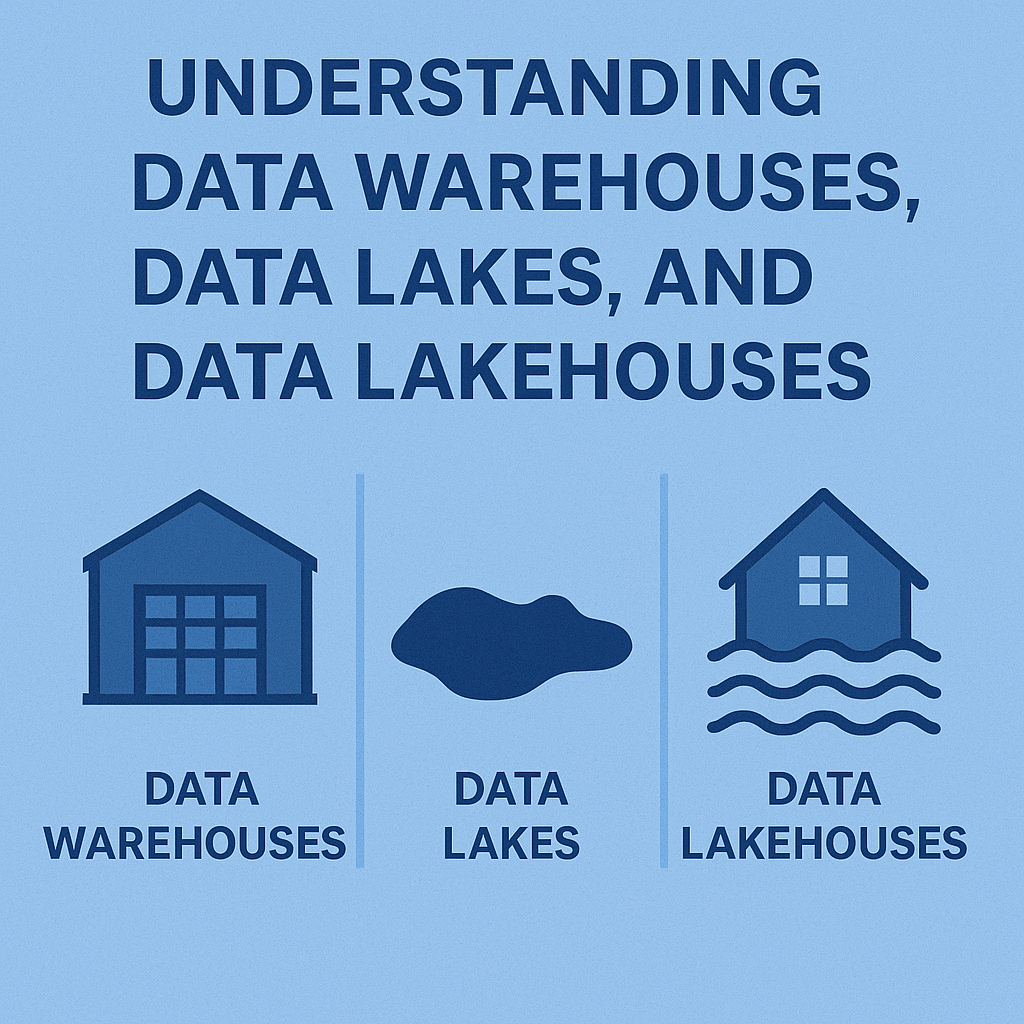Introduction
In today’s digital landscape, effective data storage and management are essential for driving operational efficiency, strategic decision-making, and long-term competitiveness. With the exponential growth of data from sources like customer interactions, IoT devices, online transactions, and social media, businesses face increasing pressure to store, process, and analyze massive and diverse datasets—commonly referred to as big data. Efficient storage ensures that this valuable data is secure and accessible, while strong data management practices uphold its quality, consistency, and usability across the organization. These capabilities are critical for uncovering insights, forecasting trends, personalizing customer experiences, and optimizing operations.
To navigate the complexities of big data, organizations turn to three core architectures: data warehouses, data lakes, and data lakehouses. A data warehouse is a centralized repository tailored for structured data and optimized for high-speed querying and business intelligence. It integrates data from various sources using predefined schemas, making it ideal for standardized reporting and analytics. However, traditional warehouses struggle to accommodate unstructured or semi-structured data.
In response, data lakes emerged to store raw data—structured, semi-structured, and unstructured—in its original format. These systems are highly scalable and flexible, favoring exploratory analysis and machine learning. Yet, their schema-on-read approach can introduce challenges related to data quality and governance.
To bridge the gap, the data lakehouse architecture was developed, combining the scalability and flexibility of data lakes with the performance, reliability, and data management strengths of warehouses. Lakehouses support diverse data types, ACID transactions, and unified analytics, simplifying data workflows and reducing infrastructure complexity. Together, these models enable modern organizations to extract meaningful insights from complex datasets and fuel innovation through data-driven strategies.
Data Warehouse
A data warehouse is a centralized system specifically built for storing and analyzing large volumes of structured data. It supports business intelligence (BI) tasks such as querying, reporting, and trend analysis. Unlike operational databases designed for real-time transactions, data warehouses are optimized for complex analytical queries across historical data, enabling timely and informed decision-making.
Data in a warehouse is stored in a highly structured format—organized into rows and columns and governed by a schema-on-write approach. This means that data must be cleaned and formatted according to a predefined schema before it is stored. As a result, data quality, accuracy, and consistency are maintained, and querying performance is significantly enhanced.
At the core of a data warehouse is the ETL (Extract, Transform, Load) process. Data is first extracted from various internal and external systems (such as CRMs, ERPs, and APIs), then transformed to align with business rules and quality standards, and finally loaded into the warehouse. This ensures that only structured, high-quality data is available for analysis.
Industries such as finance, healthcare, retail, and telecommunications frequently rely on data warehouses. For example, banks use them for fraud detection, retailers for inventory management and sales analytics, and hospitals for analyzing patient outcomes. These systems support dashboards, trend analyses, and executive reports, delivering a consistent and reliable view of business performance.
Data Lake
A data lake is a centralized repository that stores raw data in its native format—whether structured, semi-structured, or unstructured—at any scale. Unlike data warehouses, which require data to be transformed before storage, data lakes employ a schema-on-read approach. Data is stored as-is and structured only when accessed, allowing for flexible exploration and analysis.
Data lakes are built on scalable and cost-effective distributed storage platforms such as Hadoop or cloud solutions like Amazon S3. They support a broad range of data types, including log files, images, video, IoT sensor outputs, social media content, and traditional tables. Their adaptability makes them especially valuable for data scientists and analysts working on large-scale, experimental, or machine learning workloads.
Use cases for data lakes are abundant. In healthcare, researchers can combine clinical and genomic data for new discoveries. In e-commerce, businesses analyze clickstream data, reviews, and customer behavior to optimize engagement. In manufacturing or logistics, IoT devices stream real-time sensor data into the lake for immediate monitoring and action.
By accommodating vast and diverse data sources, data lakes enable organizations to maximize the value of big data through scalable, flexible, and affordable storage and processing.
Data Lakehouse
A data lakehouse is a hybrid data architecture that integrates the best elements of both data warehouses and data lakes. It combines the scalability and low-cost storage of lakes with the data governance, reliability, and performance of warehouses. This convergence allows organizations to run operational and analytical workloads—such as BI, machine learning, and real-time reporting—on a unified platform.
One of the defining features of lakehouses is their support for ACID transactions, ensuring data integrity and consistency even in complex, concurrent environments. They also implement schema enforcement, governance policies, and performance optimizations like indexing, caching, and the use of advanced file formats such as Delta Lake, Apache Iceberg, or Apache Hudi.
Lakehouses are used in diverse industries. For instance, a retailer can ingest raw data in real-time, process it for reporting, and apply machine learning for customer segmentation—all within a single environment. A financial institution can consolidate fraud detection and transaction analytics into one platform, enhancing speed and accuracy.
By eliminating the need to duplicate data between systems, lakehouses streamline workflows, reduce data latency, and lower storage and infrastructure costs. They offer a future-ready approach to data architecture, balancing flexibility with performance to meet the growing demands of enterprise data management.
Comparison: Data Warehouse vs. Data Lake vs. Data Lakehouse
| Feature / Attribute | Data Warehouse | Data Lake | Data Lakehouse |
|---|---|---|---|
| Data Type | Structured | All (structured, semi-structured, unstructured) | All |
| Schema Model | Schema-on-write | Schema-on-read | Hybrid |
| Use Cases | BI, reporting, historical analysis | ML, real-time analytics, raw data storage | Unified analytics, ML, BI |
| Performance | High for structured queries | Variable; slower for large queries | Optimized with indexing/caching |
| Scalability | Moderate | High | High |
| Governance & ACID | Strong | Weak | Strong |
| Cost | High | Low | Moderate |
| Flexibility | Low | High | High |
Summary:
- Data warehouses excel at delivering fast, reliable insights on structured data with strong governance, but are less flexible and costlier to scale.
- Data lakes offer cost-effective storage for all types of raw data, ideal for machine learning and real-time analytics, though they lack inherent governance.
- Data lakehouses combine the strengths of both, offering a versatile, integrated solution capable of handling a wide variety of workloads.
Choosing the right architecture depends on a business’s data volume, diversity, use cases, technical maturity, and analytical goals.
Conclusion
In a world increasingly shaped by data, understanding the core architectures of data warehouses, data lakes, and data lakehouses is vital. As data volume, variety, and velocity continue to grow—driven by digital platforms, IoT, and AI—organizations must adopt storage solutions that align with both current needs and future ambitions.
Each architecture offers unique advantages:
- Data warehouses provide fast, consistent analytics on structured data.
- Data lakes support flexible storage and exploration of all data types.
- Data lakehouses unify these capabilities for a comprehensive, scalable solution.
As the data landscape evolves with innovations in cloud computing, edge analytics, and AI, businesses must rethink legacy systems and embrace architectures that support agility, integration, and real-time insights. The decision is no longer just about where to store data—it’s about how to manage, govern, and activate it.
Selecting the right solution requires ongoing assessment of business needs, data types, compliance obligations, and user expectations. It also calls for continuous learning and adaptation. By fostering a culture of experimentation and staying current with emerging tools and techniques, organizations can remain agile and future-ready in a data-centric world.
In short, investing in the right data architecture—and the knowledge to manage it—isn’t just a technical decision. It’s a strategic one, foundational to innovation, competitiveness, and long-term success.

